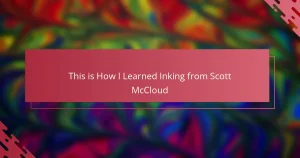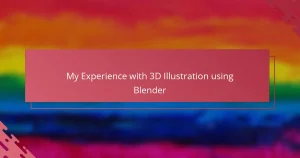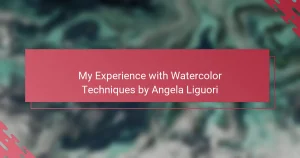Key takeaways
- Collage art involves layering various materials, textures, and colors to create cohesive and emotionally resonant compositions.
- Choosing the right materials, adhesives, and tools significantly impacts the final quality and feel of the artwork.
- Documenting the collage creation process helps identify personal preferences and fosters deeper connections to creativity.
- Showcasing collage work effectively in portfolios involves telling the story behind each piece, highlighting both process and final results.
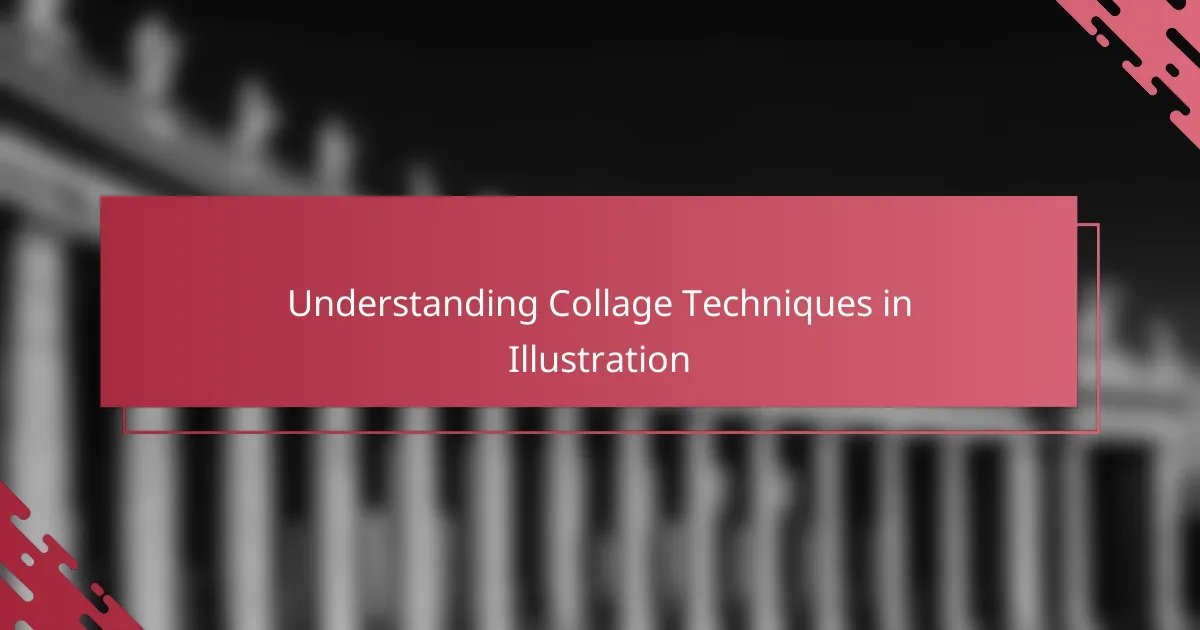
Understanding Collage Techniques in Illustration
When I first encountered collage techniques in illustration, I was struck by how effortlessly disparate elements could come together to form a cohesive image. It made me wonder—how do artists decide which materials will complement each other without creating chaos? Exploring this balance became the heart of my experimentation.
Collage isn’t just about cutting and pasting; it’s about layering textures, colors, and shapes to evoke emotions or tell a story. For me, this process felt like piecing together fragments of memories—each snippet adding depth and meaning beyond the surface. Have you ever noticed how a torn edge or an unexpected shadow can completely change the mood of a piece?
Understanding collage techniques also means embracing imperfections. I learned that the roughness of hand-cut paper or the randomness of overlapping patterns contributes to the artwork’s uniqueness. It’s this blend of control and spontaneity that keeps the technique so captivating and endlessly exciting to explore.
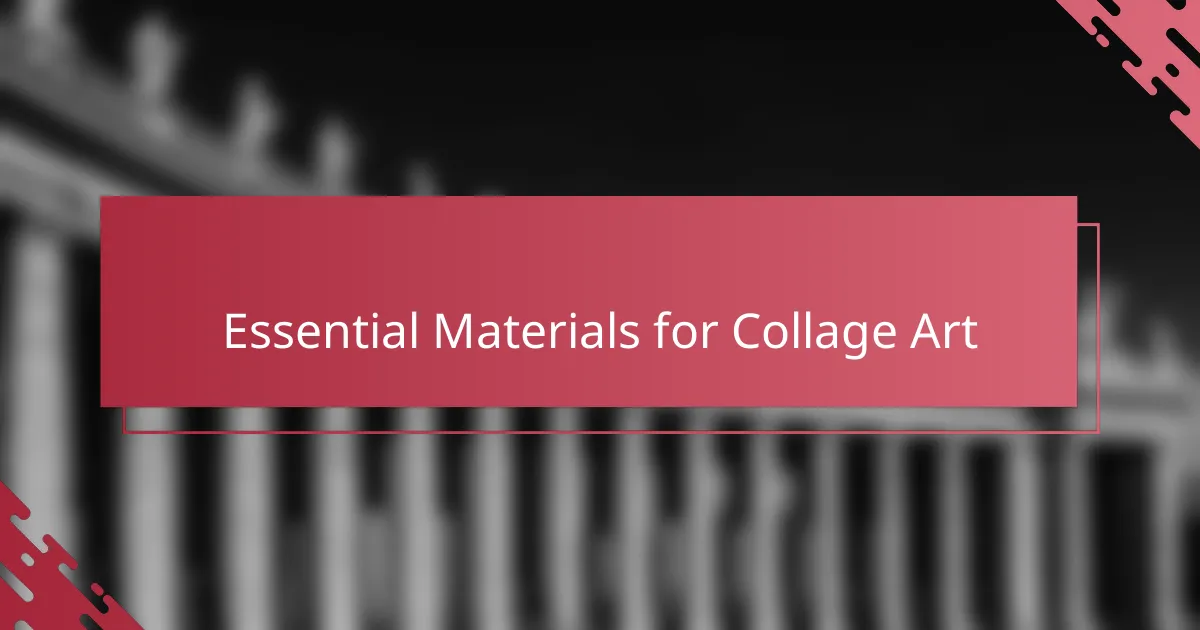
Essential Materials for Collage Art
When I first gathered my materials for collage art, I realized that the choice of paper alone could set the tone for the entire piece. From glossy magazine pages to textured handmade paper, each type brought its own personality and energy—almost like having a conversation with the materials themselves. Have you ever found yourself hesitating over which sheet to use, knowing it could shape your story in unexpected ways?
Glue was another element that surprised me more than I expected. It’s not just about sticking things down; the consistency and drying time influenced how layers interacted. I experimented with different adhesives—some wet and forgiving, others fast and precise—and quickly understood how these subtle differences affected both the process and the final texture.
Scissors and craft knives seemed basic at first, yet choosing between them opened up new possibilities for precision or roughness. I often wondered: does a clean cut convey a different emotion than a torn edge? Playing with these tools taught me how even tiny details could shift the viewer’s experience and bring my collage closer to what I envisioned.
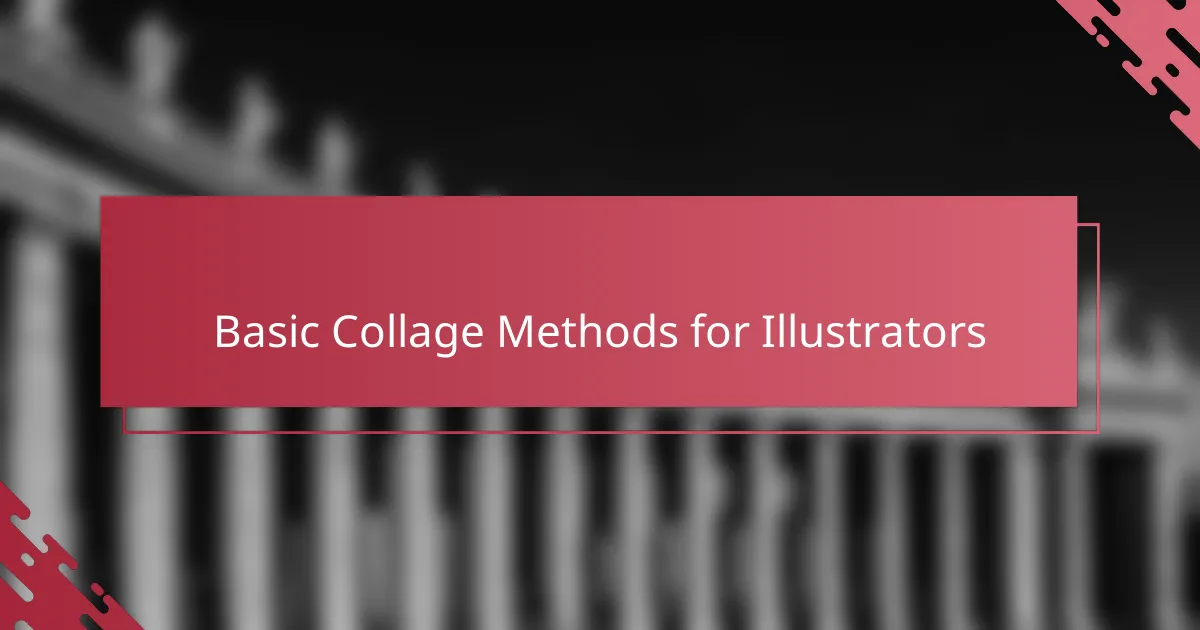
Basic Collage Methods for Illustrators
One of the simplest collage methods I tried was the classic cut-and-paste technique. At first, it felt almost meditative—carefully selecting images or textures, cutting them out, and arranging them before gluing everything down. Have you ever experienced that moment when a small shift in placement suddenly makes the whole composition click? That little revelation hooked me early on.
Layering quickly became a vital part of my process. I discovered that overlapping papers not only added visual interest but also created unexpected textures and depth. Sometimes, I’d deliberately tear edges to introduce a raw, imperfect quality—something machine-cut shapes could never replicate. This tactile element made the collage feel alive and personal to me.
Collage methods also pushed me to rethink how I approached color and contrast. I learned to balance bold hues with subtle neutrals, knowing that each piece’s tone influences the overall emotion. Do you find yourself instinctively reaching for certain colors when building layers? That intuitive choice often became the invisible thread tying my work together.
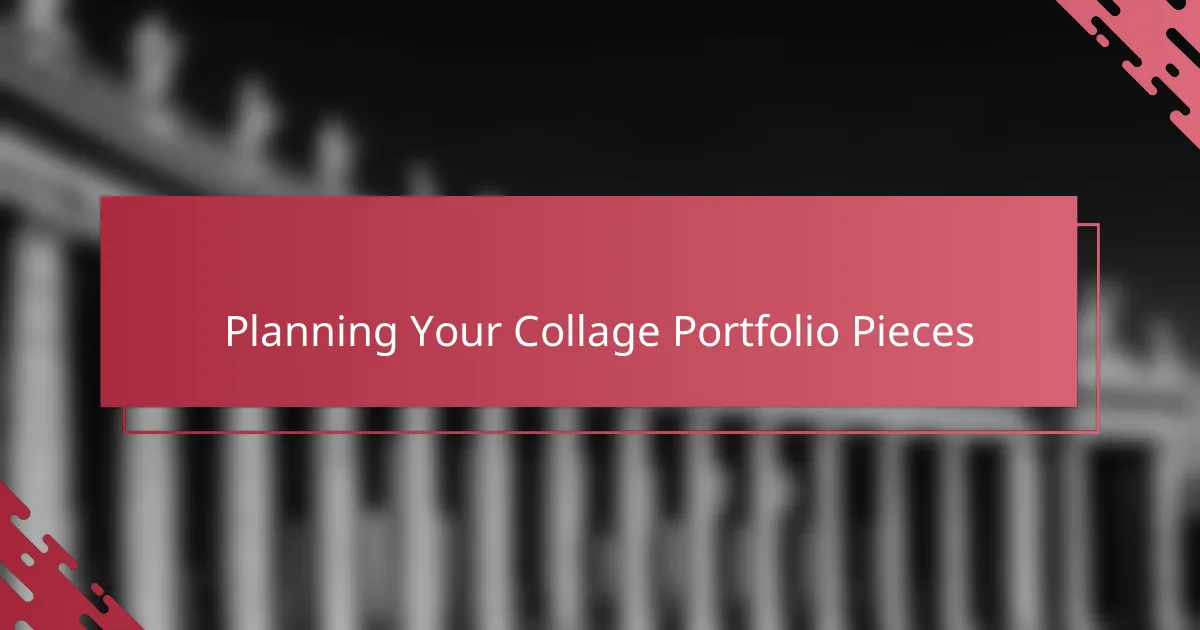
Planning Your Collage Portfolio Pieces
Planning my collage portfolio pieces felt like setting the stage for a story I wanted to tell through textures and images. I found myself sketching rough layouts in advance, but leaving enough room for spontaneity—because some of my best combinations happened by accident. Have you ever started with a clear idea, only to discover the real magic when you let go of strict plans?
Choosing which themes or emotions to explore helped me focus my work without feeling boxed in. Sometimes I wanted a series that felt whimsical and light; other times, darker and more layered. This intentionality gave each piece a sense of cohesion, even when the materials seemed wildly different.
I also learned to think about scale and balance early on. Playing with how big or small elements appeared across the composition helped me avoid visual clutter while keeping things dynamic. It’s like orchestrating a visual rhythm—where the eye can breathe but also stay engaged. Did I always get it right? Not at first, but reviewing and reworking pieces taught me to trust my instincts more.
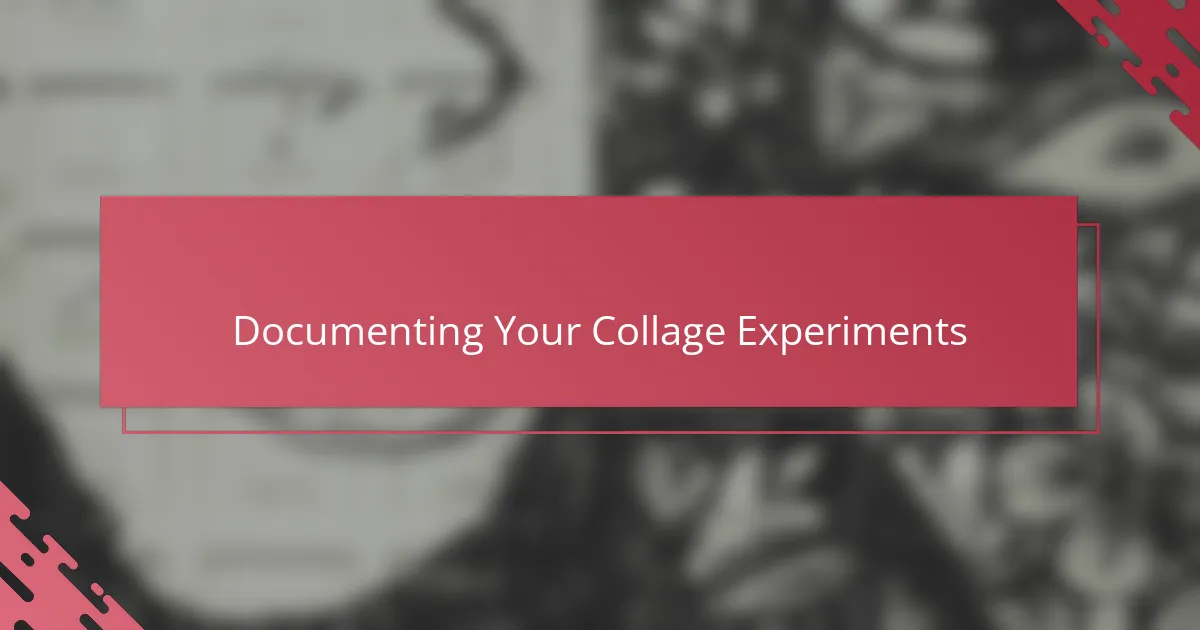
Documenting Your Collage Experiments
Documenting my collage experiments became a crucial part of my journey, almost like keeping a visual diary. I started photographing each stage—sometimes messy piles of cutouts, other times carefully layered arrangements—to capture those fleeting moments of decision and surprise. Have you ever noticed how seeing your work evolve frame by frame can reveal patterns and preferences you hadn’t consciously registered?
I also took notes alongside my images, jotting down what materials I used, how certain textures interacted, and even the emotions I felt during each experiment. This practice helped me reflect on what worked and what didn’t, turning trial and error into a purposeful learning experience. Writing it down made me realize how much intuition plays a role, while still needing structure to grow.
Looking back through my documented experiments, I often stumble upon unexpected combinations that sparked new ideas later on. It’s like having a personal archive of creative sparks that I can revisit whenever I feel stuck or need inspiration. Do you think your own creative process could benefit from such detailed documentation? From my experience, it’s an invaluable tool for deepening your connection to your craft.
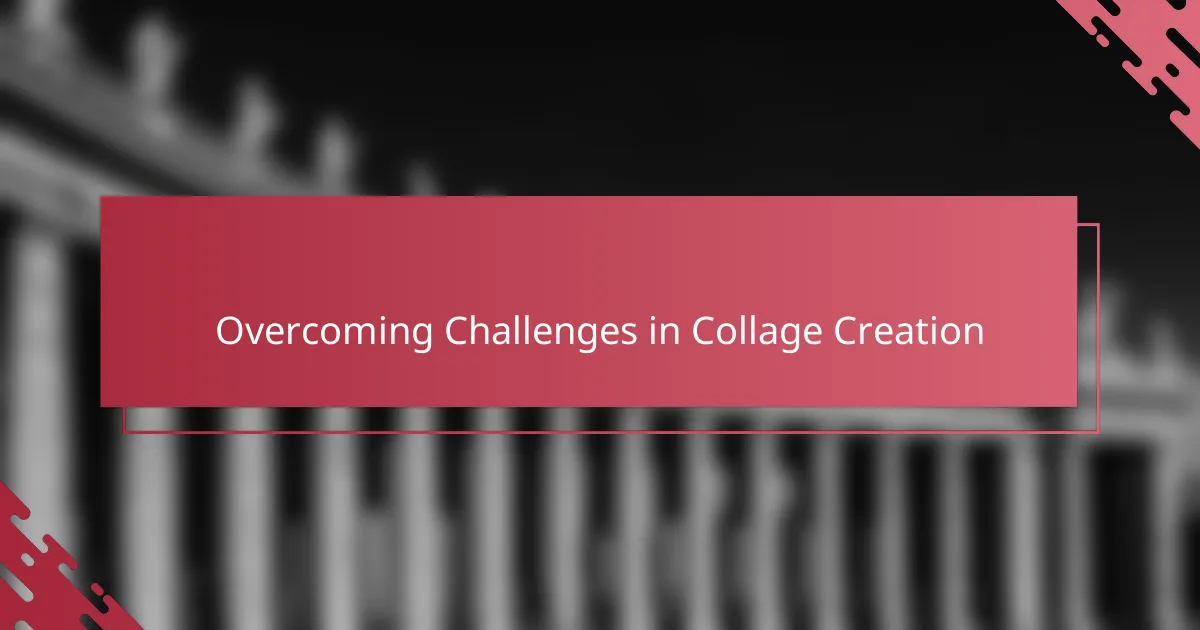
Overcoming Challenges in Collage Creation
Collage creation challenged me in ways I hadn’t anticipated—particularly when trying to balance control with creative freedom. There were moments I wrestled with frustration as layers didn’t align the way I envisioned, making me question if my choices were cohesive or just chaotic. Have you ever faced that moment when your arrangement feels off, and yet, after stepping back, the apparent disorder starts revealing its own unique harmony?
Adhesive selection was a surprising hurdle in the process. Early on, I didn’t realize how a wrong glue choice could wrinkle paper or cause unwanted shine, detracting from the texture I was aiming for. Experimenting with different glues taught me patience and precision—I learned to embrace the drying time as part of the rhythm instead of fighting it, which ultimately made my collages stronger and more resilient.
Then there was the challenge of managing imperfections—what initially felt like mistakes gradually became the artwork’s soul. I once tore paper too far and wanted to scrap the piece, but that rough edge added authenticity and tension that polished cuts couldn’t match. Have you noticed how embracing these ‘flaws’ can transform your work from neat illustrations into deeply personal stories? It’s in overcoming these challenges I found my voice as a collage artist.
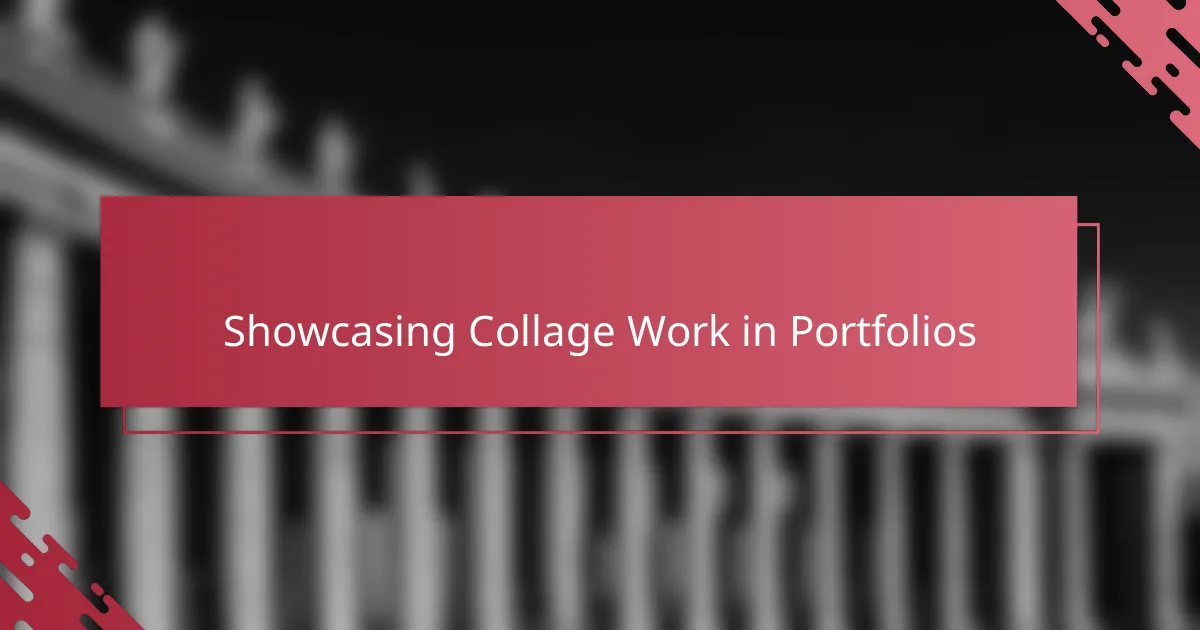
Showcasing Collage Work in Portfolios
Showcasing collage work in a portfolio isn’t just about displaying pretty images; it’s about telling the story behind each piece. I’ve found that including close-up shots of texture and layering invites viewers to appreciate the tactile nature of collage, which often gets lost in digital reproductions. Have you ever noticed how a zoomed-in detail can suddenly make the artwork feel more intimate and alive?
Organizing collage pieces alongside sketches or process photos added another layer of connection for me. When people see the evolution of a collage—from rough cutouts to the final glued composition—they engage with the artist’s journey, not just the finished product. Including these glimpses feels like sharing a secret part of the creative process, which I believe makes the portfolio more memorable.
Balancing variety and cohesion can be tricky, but I think it’s crucial in showcasing collage work effectively. In my portfolio, I aimed to present a range of techniques—from torn edges to precise cuts—while maintaining a consistent color palette or theme. This approach gave the collection a rhythm that guides the viewer smoothly from one piece to the next, rather than overwhelming them with randomness. Have you tried curating your work this way? It really changed how my portfolio felt to others.
